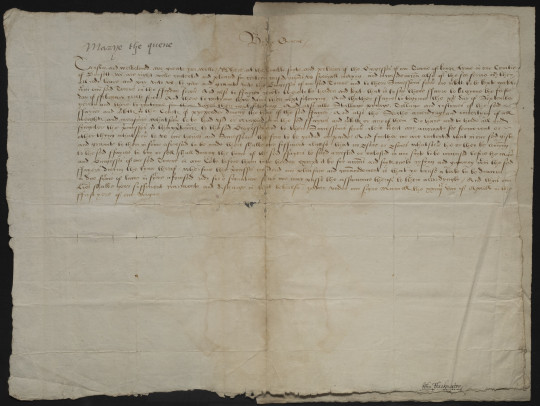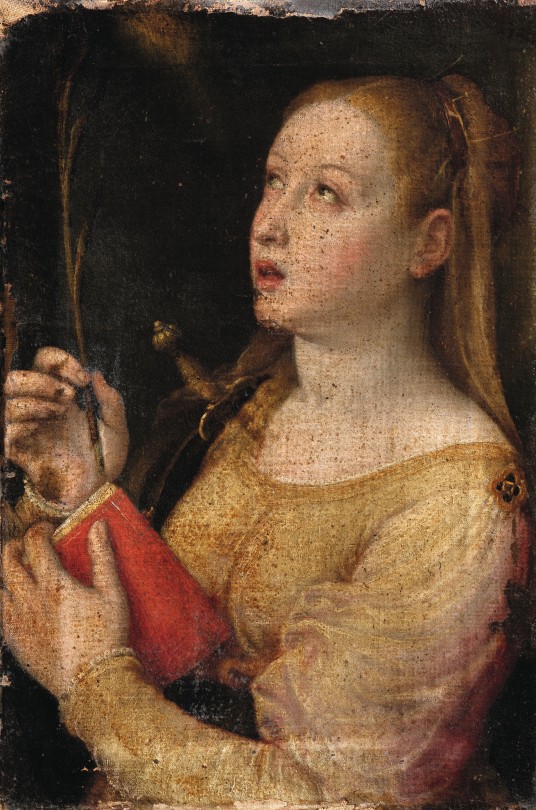#Sixteenth Century
Explore tagged Tumblr posts
Text

Sofonisba Anguissola (Italian, ca. 1532-1625): Portrait of a noblewoman, possibly Aloisia de Luna Moncada, bust-length, wearing a black embroidered dress (via Dorotheum)
#Sofonisba Anguissola#early women artists#early women painters#women artists#women painters#art#painting#sixteenth century#seventeenth century#italian painters#portrait
177 notes
·
View notes
Text

#wronghands#webcomic#humor#john atkinson#history#sixteenth century#witches#grammar#wordplay#phonics#homophones#spelling#witchcraft
116 notes
·
View notes
Text
🃏 ⤷ Twelfth Night Characters, Lines and Scene Numbers

Thought this table was pretty cool, so I copied it up onto Google Sheets to post here! :)
(Sir Toby above everyone in BOTH his amount of lines and his amount of scenes...as he should be though to be fair, what a cool guy)
(also I linked the source I got it from in the ID! ✨)
#twelfth night#what you will#william shakespeare#shakespeare#1500s#sixteenth century#16th century#1600s#seventeenth century#17th century#comedy#romantic comedy#english literature#feste#sir toby#maria#viola#sir andrew#twelfth night celebrations#christmas#cesario#sebastian#malvolio#olivia#orsino#fabian#curio#valentine#festethejester
26 notes
·
View notes
Text

#oc#art#artwork#drawing#digital art#digital#fanon#fan character#original character#oc original character#oc art#oc artwork#black#renaissance#16th century#sixteenth century#medieval#moor#renaissance period#renaissance fashion#1500s#black people#poc#spain
2 notes
·
View notes
Text

New in the Digital Library: this grant for Lyme Regis was formally issued on 14 June, 1554 and is signed "Marye the quene."
A grant of a weekly Friday market and two annual fairs to Lyme Regis. Queen Mary gives a warrant to an unidentified official to draw up the grant for the town of ’Kings Lyme’ [Lyme Regis] of a weekly Friday market and two annual three-day fairs in February and September: the grants to include all stallage, piccage [a fee for breaking ground at a fair], tollage and customs with the court of piepowder [a special tribunal for actions during the market or fair], as well as the right of correcting weights and measures; those attending the fairs may not be ’suyd arrested or molested in any suyte ... except it be for acc[i]ons and suyts onely rysyng... w[i]t[h]in the seid Fayers’. ’Where at the humble suyte and peticion of the Burgesses of our Towne of Kings Lyme in our Countie of Dorsett, we are right welle contented and pleaced ... to give and graunte unto the Burgesses of our seid Towne and to their Successours forev[er] one m[ar]kett to be kepte weekely w[ith]in our seid Towne on the Friday forev[er], And also t[w]o Fayres yerely there to be holden and kept, that is to say thone Fayre to begynne the firste day of February yerely forev[er], And there to conynue three dayes then next folowyng, And thother Fayre to begynne the xx [20th] day of September yerely and there to continue for three days then next folowyng’.
(via Grant of weekly market and two annual fairs... | MU Digital Library, University of Missouri)
#english history#british history#mary tudor#queen mary i#1500s#sixteenth century#secretary hand#manuscript#manuscripts#special collections#libraries#university of missouri#mizzou#fb#private collection#kelli h
38 notes
·
View notes
Text
My lesbian great aunt showed me what immediately became one of my favorite films ever and a comfort show.
Dangerous Beauty, released in 1998 is based on a real person- Veronica Franco, a sixteenth century courtesan in Venice.
She is a new icon of mine. I would pray to this woman
Please watch it it's incredible
#i wish i was a courtesan.#thats what i want right there#its just so beautiful#so powerful#Veronica franco is a goddess and a badass and i am so gay for her#so gay#and a little gay for marco but mostly just angry and grumpy for wasting so much of the time they could have had#dangerous beauty#Veronica franco#courtesan#sixteenth century#venice
11 notes
·
View notes
Text
youtube
I got inspired by the recently released images from Firebrand to make a whole video about the French Hood! Iconic, classic, and oh so difficult for costume designers to get right.
#period fashion#historical fashion#period drama#tudor fashion#sixteenth century#historical costume#french hood#the tudors#reign#anne boleyn#the spanish princess#becoming elizabeth#blood sex and royalty#wolf hall#the other boleyn girl#nitpicking and i know it#Youtube
17 notes
·
View notes
Text

#croquis#dessin#bande dessinée#noir et blanc#renaissance#16ième siècle#bretteur#épeiste#cape et d'épée#duel#sketch#drawing#comics#black and white#swordman#swordfight#sixteenth century#histoire#history#artists on tumblr#historical costume#costume historique
12 notes
·
View notes
Text

I checked this out from the Jersey City library -- I had searched "Sir John Davies" on the catalog, and this includes him. (His complete works have been out of print since 1875.)

Sharp start from Sir Thomas Wyatt (1502-1543), who - fun fact - was imprisoned for a period by Henry VIII on suspicion of having an affair with Anne Boleyn.
My reading of Sonnet I:
Notes:
whoso: whoever.
list: want.
hind: deer.
helas: alas.
noli me tangere: "intend not to touch me."
#poetry#books and reading#books & libraries#sonnet#poem#public libraries#sixteenth century#jersey city#new jersey#sir thomas wyatt#henry viii#anne boleyn#the tudors#history#english history#british history#britain#england#hunting#deer
9 notes
·
View notes
Text

Barbara Longhi (Italian, 1552-1638): Saint Justina of Padua (via Dorotheum)
#Barbara Longhi#Saint Justina of Padua#early women painters#early women artists#sixteenth century#seventeenth century#italian painters#religious art#women artists#women painters#art#painting
194 notes
·
View notes
Text
𝐌𝐢𝐜𝐡𝐞𝐥 𝐝𝐞 𝐌𝐨𝐧𝐭𝐚𝐢𝐠𝐧𝐞 𝐡𝐚𝐝 𝐚𝐧 𝐀𝐪𝐮𝐚𝐫𝐢𝐮𝐬 𝐒𝐭𝐞𝐥𝐥𝐢𝐮𝐦 𝐢𝐧 𝐭𝐡𝐞 𝟖𝐭𝐡 𝐇𝐨𝐮𝐬𝐞 𝐚𝐧𝐝 𝐭𝐡𝐚𝐭 𝐞𝐱𝐩𝐥𝐚𝐢𝐧𝐬 𝐚 𝐥𝐨𝐭.
#montaigne#essais#astrology#esoterism#occultism#symbolism#renaissance#literature#sixteenth century#renaissance writer#aquarius#uranus#8th house#pluto#stellium#aquarius stellium#8th house stellium#astrology observations#astrology in celebre figures
1 note
·
View note
Text
🃏 ⤷ "Look like th' innocent / flower, / But be the serpent under 't." [Macbeth 1.5.76-78]
#shakespeare qotd#shakespeare quote of the day#william shakespeare#shakespeare#1500s#sixteenth century#16th century#1600s#seventeenth century#17th century#tragedy#english literature#festethejester#macbeth#lady macbeth
14 notes
·
View notes
Text
Medici Heist by Caitlin Schneiderhan
Publisher : Atom (6 Aug. 2024)Language : EnglishHardcover : 432 pagesISBN-10 : 0349125392ISBN-13 : 978-0349125398 Book Blurb Welcome to Florence, 1517, a world of intrigue and opulence, murder and betrayal. Sharp-witted conwoman Rosa Cellini arrives in the city the same day that the Medici Pope, Leo X, returns to take up the reins of power. This is not a coincidence. The new…

View On WordPress
#blogtour#Adventure#Art History#Book Blogger#Book Recommendation#Book review#Bookliterati#Caitlin schneiderhan#Fiction#Florence#Historical Fiction#History#Italy#Little Brown Books#Medici#Medici Heist#Romance#Secrets#Sixteenth Century#Suspense#thriller
1 note
·
View note
Text
Review: The Medici Heist by Caitlin Schneiderhan
The Medici HeistCaitlin SchneiderhanFeiwel & FriendsPublished August 6, 2024 Amazon | Bookshop | Goodreads About The Medici Heist Welcome to Florence, 1517, a world of intrigue, opulence, secrets, and murder. The Medici family rules the city from their seat of wealth, but the people of Florence remember the few decades they spent as a Republic, free from the Medicis and their puppet Pope, Leo…
0 notes
Text

This absolute failure of a class traitor, omg
1 note
·
View note
Video
youtube
Luys de Narvaez (c.1500-1555): Paseábase el rey moro & Anon: Gaybatuk, B...
Paseábase el rey moro por la ciudad de Granada desde la puerta de Elvira hasta la de Vivarrambla. ¡Ay de mi Alhama! Cartas le fueron venidas que su Alhama era ganada: las cartas echó en el fuego y al mensajero matara, ¡Ay de mi Alhama! Descabalga de una mula, y en un caballo cabalga; por el Zacatín arriba, subido se había al Alhambra. ¡Ay de mi Alhama! Como en el Alhambra estuvo al mismo punto mandaba que se toquen sus trompetas, sus añafiles de plata. ¡Ay de mi Alhama! Y que las cajas de guerra apriesa toquen al arma, porque lo oigan sus moros, los de la Vega y Granada. ¡Ay de mi Alhama! Los moros que el son oyeron que al sangriento Marte llama, uno a uno y dos a dos juntado se ha gran batalla. ¡Ay de mi Alhama! Allí fabló un moro viejo, de esta manera fablara: -¿Para qué nos llamas, rey, para qué es esta llamada? ¡Ay de mi Alhama! -Habéis de saber, amigos, una nueva desdichada: que cristianos de braveza ya nos han ganado Alhama. ¡Ay de mi Alhama! Allí fabló un alfaquí de barba crecida y cana: -Bien se te emplea, buen rey, buen rey, bien se te empleara. ¡Ay de mi Alhama! Mataste los Bencerrajes, que eran la flor de Granada: cogiste los tornadizos de Córdoba la nombrada. ¡Ay de mi Alhama! Por eso mereces, rey, una pena muy doblada: que te pierdas tú y el reino, y aquí se pierda Granada. ¡Ay de mi Alhama!
English translation by Lord Byron
The Moorish King rides up and down, Through Granada’s royal town; From Elvira’s gate to those Of Bivarambla on he goes. Woe is me, Alhama!
Letters to the monarch tell How Alhama’s city fell: In the fire the scroll he threw, And the messenger he slew. Woe is me, Alhama!
He quits his mule, and mounts his horse, And through the street directs his course; Through the street of Zacatin To the Alhambra spurring in. Woe is me, Alhama!
When the Alhambra walls he gain’d, On the moment he ordain’d That the trumpet straight should sound With the silver clarion round. Woe is me, Alhama!
And when the hollow drums of war Beat the loud alarm afar, That the Moors of town and plain Might answer to the martial strain. Woe is me, Alhama!
Then the Moors, by this aware, That bloody Mars recall’d them there, One by one, and two by two, To a mighty squadron grew. Woe is me, Alhama!
Out then spake an aged Moor In these words the king before, ‘Wherefore call on us, oh King? What may mean this gathering?’ Woe is me, Alhama!
‘Friends! ye have, alas! to know Of a most disastrous blow; That the Christians, stern and bold, Have obtain’d Alhama’s hold.’ Woe is me, Alhama!
Out then spake old Alfaqui, With his beard so white to see, ‘Good King! thou art justly served, Good King! this thou hast deserved. Woe is me, Alhama!
‘By thee were slain, in evil hour, The Abencerrage, Granada’s flower; And strangers were received by thee Of Cordova the Chivalry. Woe is me, Alhama!
‘And for this, oh King! is sent On thee a double chastisement: Thee and thine, thy crown and realm, One last wreck shall overwhelm. Woe is me, Alhama!
#music#sixteenth century#luys de narvaez#ballads#mudejar#spanish romances#sixteenth century music#youtube#english translation#translated lyrics#lord byron
0 notes